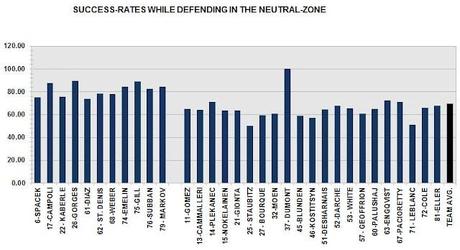- Neutral-zone puck-battles
- Lost neutral-zone puck-battles
- Neutral-zone loose-puck recoveries
- Lost races to loose-pucks in the neutral-zone
- Blocked/intercepted passes
- Failed Blocked/ intercepted passes (puck goes under stick or through legs)
- Successful poke-checks
These results are restricted to even-strength play in the neutral-zone.

Gabriel Dumont earned the top defensive-rating in the neutral-zone. That said, he engaged in a limited number of neutral-zone events. Therefore, his results are incomplete. The same can be said for Andreas Engqvist.
FORWARDS
Among forwards with significant neutral-zone events, the top defensive-rating in the neutral-zone was earned by Tomas Plekanec. Plekanec was successful with 71% of his defensive-events in the neutral-zone. He won only 44% of his neutral-zone puck-battles, but recovered 120 loose-pucks. He also intercepted 50 opposition passes. In terms of percentage, he was able to get his stick or body on 67% of opposition players' high-risk passes (under his stick/through his legs).
The only other player with a success-rate above 70% was Max Pacioretty. Pacioretty was successful with 70% of his defensive-events in the neutral-zone. He won 51% of his neutral-zone puck-battles, and recovered 154 loose-pucks. He intercepted 51 opposition passes, and was able to get his stick or body on 57% of opposition players' high-risk passes.
The lowest success-rates belonged to Brad Staubitz (50%), and Louis Leblanc (51%). Leblanc won only 32% of his neutral-zone puck-battles, while Staubitz was not able to intercept any opposition passes in the neutral-zone.
DEFENSEMEN
Defensemen's positioning allows them the opportunity to see the play develop. As such, their defensive-ratings in the neutral-zone are significantly higher than forwards. Forwards are often forcing the passer; this makes it more difficult to block passes, as their positioning doesn't give them enough reaction-time. Defensemen, on the other hand, are usually positioned more closely to the receiver of the pass, thereby allowing more time to intercept or block the pass.
Among defensemen, the top defensive-rating in the neutral-zone belonged to Josh Gorges. Gorges was successful with an incredible 90% of his defensive-events in the neutral-zone. He won 66% of his neutral-zone puck-battles, and recovered 83 loose-pucks. He intercepted 44 opposition passes; for a success-rate of 81%. He was also successful with 28 attempted poke-checks.
Other d-men with success-rates above 84% include; Chris Campoli (88%), Alexei Emelin (84%), and Andrei Markov (85%). Campoli and Emelin did a solid job intercepting passes, while Markov won 80% of his neutral-zone puck-battles.
Raphael Diaz (74%) and Tomas Kaberle (76%) had the lowest defensive-rating in the neutral-zone. Kaberle won only 44% of his neutral-zone puck-battles, while Diaz won only 45% of his n-zone puck-battles. Both players also had low success-rates when attempting to intercept opposition-passes.
